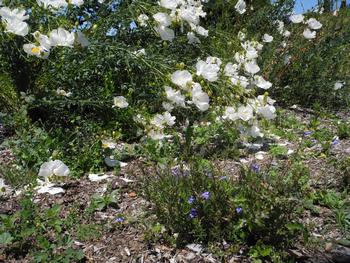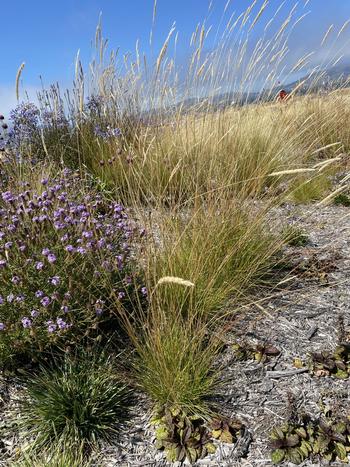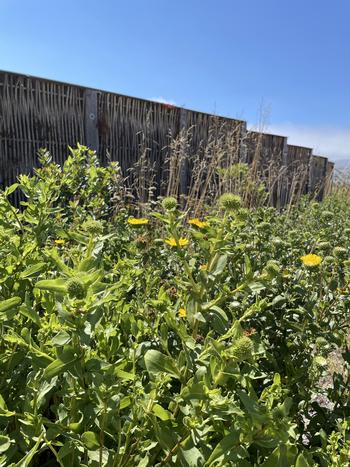Practical ways to grow a more resilient garden
-
Anne-Marie Walker
-
As extreme weather conditions occur worldwide, there are things gardeners can do to make gardens more resilient. Careful plant selection is the first step. A perennial is a woody or herbaceous plant that lives from year to year and does not die after flowering once. Annual plants complete their life cycle in under a year and have shallow, fine roots that decompose easily. Perennials have deep root systems that access moisture more effectively and efficiently during dry periods. During stormy periods, prevent root rot with well-composted soil, build berms to store excess water, and divert water with swales. UC Riverside is researching the response of roots to flood stress; a key finding is that the roots of rice, a perennial, produce the lipid molecule suberin that helps water reach the shoots and helps oxygen in the shoots reach the roots. Research continues to determine if suberin can help plants combat climate change.
 Rhizomatous shrubs like this native Matilijia poppy have nodes along their stems which sprout roots to spread the plant. Photo: Anne-Marie WalkBuilding soil health is a proven practice to build resilient gardens. Current studies at UC Davis confirm planting cover crops improves and helps soil capture and store more water, which is important as we implement California’s Sustainable Groundwater Management Act. Another important finding is California native species as crop cover works well in no-till orchards and gardens where the impact of growing rain-dependent winter cover crops is impacted by drought. Beekeepers and farmers began planting the California native Phacelia Tanacetifolia (Lacy Phacelia) to support native pollinators, build soil health, and reduce water use. Lupine, also a native plant, helps build soil by forming an association with nitrogen-fixing bacteria in roots. To learn about the potential ecological attributes of native plants, more information can be found at https://ucanr.edu/sites/covercrops/.
Rhizomatous shrubs like this native Matilijia poppy have nodes along their stems which sprout roots to spread the plant. Photo: Anne-Marie WalkBuilding soil health is a proven practice to build resilient gardens. Current studies at UC Davis confirm planting cover crops improves and helps soil capture and store more water, which is important as we implement California’s Sustainable Groundwater Management Act. Another important finding is California native species as crop cover works well in no-till orchards and gardens where the impact of growing rain-dependent winter cover crops is impacted by drought. Beekeepers and farmers began planting the California native Phacelia Tanacetifolia (Lacy Phacelia) to support native pollinators, build soil health, and reduce water use. Lupine, also a native plant, helps build soil by forming an association with nitrogen-fixing bacteria in roots. To learn about the potential ecological attributes of native plants, more information can be found at https://ucanr.edu/sites/covercrops/. Native grasses drift among perennials including the shrub Verbena lilacina ‘de la Mina’ at Tunnel Tops, GGNRA. Photo: Anne-Marie Walker
Native grasses drift among perennials including the shrub Verbena lilacina ‘de la Mina’ at Tunnel Tops, GGNRA. Photo: Anne-Marie WalkerTo survive unfavorable environmental conditions, plants utilize a variety of mechanisms, including storing food reserves, dormancy (plants can be alive but not growing), and delaying seed germination until specific environmental conditions occur. Use these mechanisms to build garden resiliency. Would it surprise you to learn that a daffodil is a perennial plant? While the aboveground part of the daffodil dies back each year, the underground part lives on, allowing the daffodil to regrow each year. That demonstrates resilience but perhaps not enough as temperatures rise. Milder winters in Marin may mean it will be harder to grow many bulbs, including daffodils, tulips, crocus, and hyacinths, because they are not getting sufficient chill hours required to initiate flowering. What’s a gardener to do? Select native bulbs better suited to warmer garden conditions like Allium unifolium (One leaf onion), Triteleia laxa (Ithuriel’s spear), and Triteleia ixioides (Prettyface). These California native bulbs bloom in late April through May, pair well with Eschscholzia californica (California poppies), require no summer water, and are visited by many butterflies. Go to https://www.calscape.org/ to see butterfly and pollinator preferences.
Design has helped make gardens more resilient for hundreds of years. During particularly cold periods, garden walls were built, and windbreaks were planted. Now, driven by climate change, a new garden aesthetic is evolving. In NYC, the High Line is a “prairie garden in the sky.” In San Francisco, Tunnel Tops is a coastal garden that dazzles with spectacular vistas, playful public spaces, and garden beds planted with drought-hardy perennials providing habitat for insects and birds. The prairie-style planting in both public gardens covers the most bare ground in order to store maximum carbon underground and reduce maintenance. You can duplicate this garden design in many different sizes of planting beds. First, create a drift of herbaceous perennial shrubs mixed through with native grasses and bulbs. Then, plan to let the native plants grow together while providing visual interest and benefit for wildlife. Fall is the perfect time to plant, and as the plants grow, resilience builds in your garden, sure to delight many visitors. A wall provides a wind break at Tunnel Tops, GGNRA, for Gumweed (Grindelia stricta) which like moisture from fog. Photo: Anne-Marie Walker
A wall provides a wind break at Tunnel Tops, GGNRA, for Gumweed (Grindelia stricta) which like moisture from fog. Photo: Anne-Marie Walker



